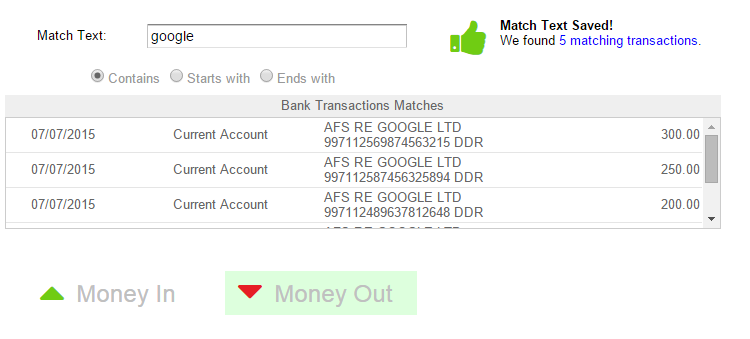Automated bank tagging rules
Please Note: Bank tagging rules are a very powerful automation tool and can create 100s of invoices automatically when you upload your bank statement. We recommend that you start by keeping the auto-tagging feature switched off, or to configure your rules for manual approval until you are confident that the rules are working as intended.
Introduction
Automated bank tagging allows you to get your bookkeeping done much faster by teaching QuickFile how to deal with certain transactions. Rather than continuously tagging routine entries on your bank statement, simply setup a rule and QuickFile will do the bank tagging for you.What is a Bank Tagging Rule?
A bank tagging rule is a simple filter that checks any new transactions arriving in your bank. Whether the transaction is uploaded from a CSV, imported from a feed or entered manually. The rule looks for some matching text in the new transaction and tags the item according to your preferences.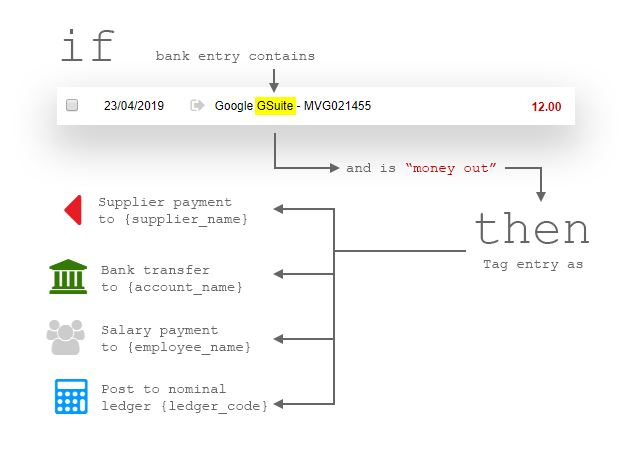
How do I create a Bank Tagging Rule?
You can setup as many bank tagging rules as you like, there are two basic ways to do this:1. Dynamic Rule Creation
When you are tagging your bank transactions you will see an option to create a new rule at the point you tag and save the item. This rule will take the text from the corresponding bank transaction and configure a rule that matches the allocation you have just made. The rule will then be applied to any matching future transactions and will be tagged in the same way.
2. Manual Rule Creation
You can also create bank tagging rules manually within the rule management area. You can get to the rule management area by selecting "Banking">>"Bank tagging rules" from the main horizontal menu: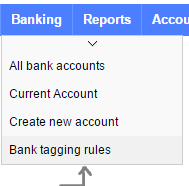
You can also get to rule management area from the main banking screen:

You will then see a green button to add a new rule:
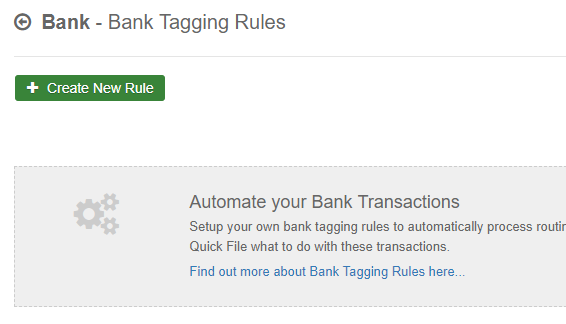
When creating a new rule you start by entering some text to match. Say for example we enter ‘Google’, this will match any transactions containing the word Google (e.g. Google Adwords MV002142). You don’t need to worry about the case, all rules are case insensitive. When you enter your matching text QuickFile will quickly scan your current bank transactions to see if anything would get picked up. It is a good way to see if your rule will be effective.
You can now choose whether to match ‘Money In’ or ‘Money Out’ transactions and assign an action to inform QuickFile how to handle matching transactions.
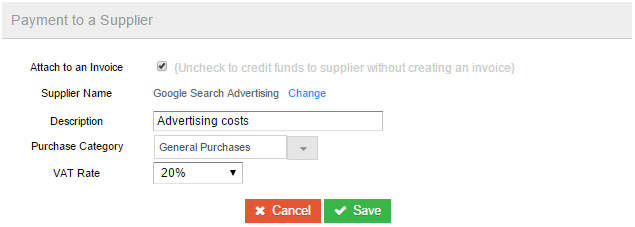
Once you’ve saved the rule it will appear on the main list. Form here you can quickly search other rules and rank your rules in order of usage.
Auto Tagging
When you enter new transactions into QuickFile, they will automatically be cross-checked with any rules you have saved on your account. If the transaction matches against a rule it will appear orange on your bank statement with a button that allows you to review and confirm the rule. We call this ‘semi-automated bookkeeping’ as it relies on your stewardship to ensure that the rule is manually approved.Over time you may feel confident enough to allow QuickFile to automatically action your rules without manual approval. For this to take place you will need to switch on ‘Auto Tagging’. You will find the switch in the rule management area, you can switch it on and off as you please.
When Auto Tagging is switched on, the new transactions will show as pending once entered into QuickFile. All pending items are routinely tagged by QuickFile at intervals throughout the day, and you don’t need to be logged in for this to happen. You can upload your items, log off and return later to see them all tagged.
Please Note: Extra care should always be taken with auto tagging to avoid unwanted or inaccurate items from corrupting your account
Manual Confirmation Mode
You can still have auto-tagging switched on while setting individual rules for manual confirmation. This is a useful way to test any new rules you have created, or to simply bring certain entries on your bank to your attention.

When auto-tagging is switched on you will notice a traffic light control which indicates how the rule will be invoked. Setting the rule to amber will ensure that any corresponding bank entries will never be automatically tagged but instead marked for your approval.

